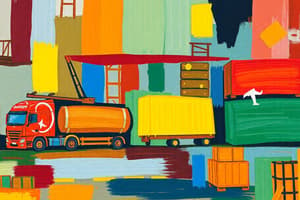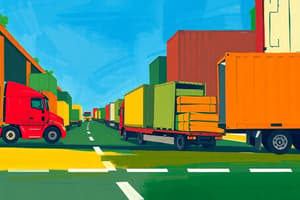Podcast
Questions and Answers
What is a primary role of transportation within a supply chain?
What is a primary role of transportation within a supply chain?
- To facilitate the movement of products between different locations. (correct)
- To eliminate the need for product movement between locations.
- To ensure products are consumed in the same location they are produced.
- To minimize the cost component associated with product storage.
Which mode of transportation typically handles the largest volume of freight in terms of tons?
Which mode of transportation typically handles the largest volume of freight in terms of tons?
- Water
- Rail
- Air
- Truck (correct)
Which of the following is a key issue to consider when dealing with air transportation?
Which of the following is a key issue to consider when dealing with air transportation?
- Maintenance schedules.
- The location and number of hubs.
- Crew scheduling.
- All of the above. (correct)
Which transportation mode has the lowest value added to the GNP?
Which transportation mode has the lowest value added to the GNP?
Which of the following is the best definition of a 'shipper'?
Which of the following is the best definition of a 'shipper'?
A company needs to transport a shipment of perishable goods across the country as quickly as possible. Which transportation mode is the MOST suitable?
A company needs to transport a shipment of perishable goods across the country as quickly as possible. Which transportation mode is the MOST suitable?
Which mode of transportation is MOST appropriate for transporting crude oil from a production site to a refinery?
Which mode of transportation is MOST appropriate for transporting crude oil from a production site to a refinery?
A business is looking to minimize transportation costs for a very large shipment of goods from China to the United States. Which mode of transport should they use?
A business is looking to minimize transportation costs for a very large shipment of goods from China to the United States. Which mode of transport should they use?
A company wants to ship goods from a supplier in one country to a customer in another country, the company wants to ensure that they only deal with one entity throughout the shipping process. Which transportation solution is best suited?
A company wants to ship goods from a supplier in one country to a customer in another country, the company wants to ensure that they only deal with one entity throughout the shipping process. Which transportation solution is best suited?
What is a key challenge that must be addressed to ensure the effectiveness of intermodal transportation solutions?
What is a key challenge that must be addressed to ensure the effectiveness of intermodal transportation solutions?
A company wants to minimize inventory costs while maintaining simple coordination. Which network structure is most suitable?
A company wants to minimize inventory costs while maintaining simple coordination. Which network structure is most suitable?
Which transportation network is MOST effective at minimizing inventory while potentially increasing coordination complexity?
Which transportation network is MOST effective at minimizing inventory while potentially increasing coordination complexity?
What is the primary disadvantage of using a 'tailored network' for transportation?
What is the primary disadvantage of using a 'tailored network' for transportation?
A company aims to reduce transportation costs for small lots and decrease inventory levels. Which strategy would be MOST effective?
A company aims to reduce transportation costs for small lots and decrease inventory levels. Which strategy would be MOST effective?
What is the main trade-off when deciding on a transportation mode?
What is the main trade-off when deciding on a transportation mode?
According to the ranking of transportation modes, which mode is generally the LEAST preferable when prioritizing low cycle inventory?
According to the ranking of transportation modes, which mode is generally the LEAST preferable when prioritizing low cycle inventory?
When is inventory aggregation most beneficial for a supply chain?
When is inventory aggregation most beneficial for a supply chain?
What is the primary trade-off when a company chooses to increase its customer responsiveness?
What is the primary trade-off when a company chooses to increase its customer responsiveness?
A company decides to use different transportation modes based on the specific needs of its customers and the characteristics of its products. What is this strategy known as?
A company decides to use different transportation modes based on the specific needs of its customers and the characteristics of its products. What is this strategy known as?
What is the key difference between an intermediate transit point with storage and one with cross-docking?
What is the key difference between an intermediate transit point with storage and one with cross-docking?
How do delivery costs typically change as the number of deliveries increases in a tailored transportation strategy?
How do delivery costs typically change as the number of deliveries increases in a tailored transportation strategy?
In the context of transportation network design, what does a 'milk run' primarily aim to achieve?
In the context of transportation network design, what does a 'milk run' primarily aim to achieve?
If a company wants to minimize inventory holding costs while maintaining responsiveness to customer demand, which transportation network design should they choose?
If a company wants to minimize inventory holding costs while maintaining responsiveness to customer demand, which transportation network design should they choose?
In what scenario would a direct shipment network be most appropriate, compared to shipping via an intermediate distribution center?
In what scenario would a direct shipment network be most appropriate, compared to shipping via an intermediate distribution center?
When designing a transportation network, which consideration primarily addresses the trade-off between transportation cost and responsiveness?
When designing a transportation network, which consideration primarily addresses the trade-off between transportation cost and responsiveness?
According to Table 14-10, which transportation option is most suitable for a scenario with medium customer density and a medium distance?
According to Table 14-10, which transportation option is most suitable for a scenario with medium customer density and a medium distance?
Based on Table 14-10, what transportation strategy is generally recommended for areas characterized by high customer density and long distances?
Based on Table 14-10, what transportation strategy is generally recommended for areas characterized by high customer density and long distances?
As per Table 14-11, what inventory and transportation strategy is most appropriate for a product with high value and low demand?
As per Table 14-11, what inventory and transportation strategy is most appropriate for a product with high value and low demand?
Considering Table 14-11, which strategy is best suited for a product that has both high value and high demand?
Considering Table 14-11, which strategy is best suited for a product that has both high value and high demand?
According to Table 14-11, what is the recommended approach for managing inventory and transportation when dealing with a low-value, low-demand product?
According to Table 14-11, what is the recommended approach for managing inventory and transportation when dealing with a low-value, low-demand product?
Flashcards
Package Carriers
Package Carriers
Transport small packages, typically under 150 pounds, quickly and reliably.
Truckload (TL)
Truckload (TL)
Shipping method with low fixed costs for larger shipments, focused on full truckloads.
Less than Truckload (LTL)
Less than Truckload (LTL)
Shipping of small lots using a hub and spoke system; may take longer than TL.
Intermodal Transportation
Intermodal Transportation
Signup and view all the flashcards
Pipeline Transportation
Pipeline Transportation
Signup and view all the flashcards
Supply Chain Transportation
Supply Chain Transportation
Signup and view all the flashcards
Types of Transportation Modes
Types of Transportation Modes
Signup and view all the flashcards
Freight Value in 2011
Freight Value in 2011
Signup and view all the flashcards
Air Transportation Costs
Air Transportation Costs
Signup and view all the flashcards
Key Issues in Air Transportation
Key Issues in Air Transportation
Signup and view all the flashcards
Transportation Network Design
Transportation Network Design
Signup and view all the flashcards
Direct Shipment
Direct Shipment
Signup and view all the flashcards
Milk Run
Milk Run
Signup and view all the flashcards
Cross-Docking
Cross-Docking
Signup and view all the flashcards
Distribution Center (DC)
Distribution Center (DC)
Signup and view all the flashcards
Direct Shipping
Direct Shipping
Signup and view all the flashcards
Trade-offs in Transportation Design
Trade-offs in Transportation Design
Signup and view all the flashcards
Tailored Network
Tailored Network
Signup and view all the flashcards
Transportation Modes Ranking
Transportation Modes Ranking
Signup and view all the flashcards
Inventory Aggregation
Inventory Aggregation
Signup and view all the flashcards
Trade-Off in Transportation Costs
Trade-Off in Transportation Costs
Signup and view all the flashcards
Tailored Transportation
Tailored Transportation
Signup and view all the flashcards
Temporal Aggregation
Temporal Aggregation
Signup and view all the flashcards
Transportation Options
Transportation Options
Signup and view all the flashcards
Short Distance Transportation
Short Distance Transportation
Signup and view all the flashcards
Medium Distance Transportation
Medium Distance Transportation
Signup and view all the flashcards
Aggregation Strategies
Aggregation Strategies
Signup and view all the flashcards
High Demand Product Strategy
High Demand Product Strategy
Signup and view all the flashcards
Study Notes
Transportation in a Supply Chain
- Transportation is a significant cost component in a supply chain, moving products from one location to another.
- Products are rarely produced and consumed in the same location.
- The shipper initiates the movement, while the carrier transports the product.
Transportation Modes and Their Role
- Air: A fast mode, but with high fixed infrastructure and equipment costs. Variable costs depend on passenger/cargo. Key issues include hub locations, fleet assignments, maintenance, crew scheduling, and pricing/availability.
- Package carriers: Primarily for small packages up to 150 pounds. Characterized by high expense and rapid/reliable delivery, including value-added services and shipment consolidation.
- Truck: Relatively significant fraction of goods moved. Different classes exist, such as truckload (TL) with low fixed costs and imbalance between flows. Less than truckload (LTL) involves smaller lots, hub-and-spoke systems, and longer transit times, with potential for fatigue-related accidents.
- Rail: Moves commodities over long distances with high fixed costs in equipment/facilities. Scheduled for maximum utilization, transit time can be long as trains aren't as flexible as other modes.
- Water: Primarily for large loads at low costs, limited to geographic areas like oceans, inland waterways, and coastal waters. It's the slowest mode and dominant in global trade, frequently using containers.
- Pipeline: Primarily used for crude petroleum, refined petroleum products, and natural gas. High fixed costs and optimal for large, stable flows with predictable demand.
- Intermodal: Uses multiple transportation modes in a single shipment. Increased use of containers has led to greater efficiency and global trade conveniences. Key issue involves seamless information exchange between different modes.
Transportation Infrastructure and Policies
- Governments often take primary responsibility or play a significant role in managing infrastructure elements.
- Deregulation and market forces help create effective industry structure without monopolies.
- Pricing should reflect the marginal impact on society's overall cost.
Design Options for a Transportation Network
- Direct shipping decision: Directly from supplier to buyer, avoiding intermediate locations.
- Intermediate site stock/cross-docking: Whether the intermediate site stocks product or acts as a cross-docking location.
- Delivery routes: Should each delivery route supply one destination or multiple destinations?
Direct Shipment Network Diagrams
- Presented in images, illustrating direct shipping, milk runs, and use of intermediate distribution centers (DC) and cross-docking facilities
Transportation Network Trade-offs, Aggregation, and Modes
- Trade-offs between transportation cost, inventory costs, and customer responsiveness
- Inventory aggregation, particularly important for products with large value-to-weight ratios or high demand uncertainties.
- Choosing specific transportation mode depends on customer/product characteristics (customer density/distance, customer size), total route distance, number of deliveries, and product demand/value.
- A table (14-3) ranks transportation modes based on various factors like cycle inventory, safety inventory, in-transit cost, transportation cost, and transit time. See the Table for detailed rankings.
- Transportation trade-offs are closely linked to the degree of responsiveness desired. High responsiveness tends to come with higher transportation costs, while decreased responsiveness leads to lower transportation costs.
- Temporal aggregation involves combining orders across time to optimize transportation.
Studying That Suits You
Use AI to generate personalized quizzes and flashcards to suit your learning preferences.




